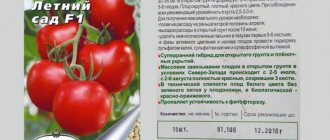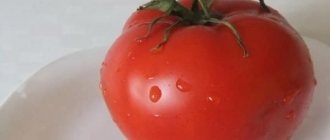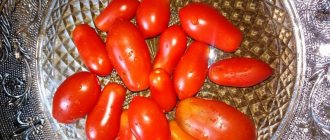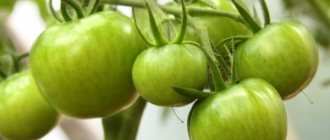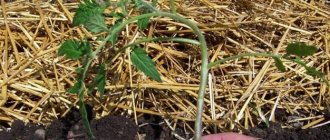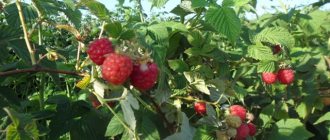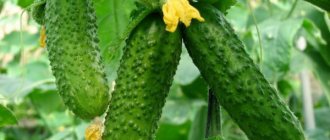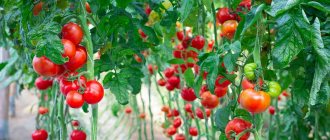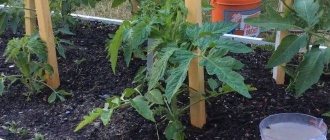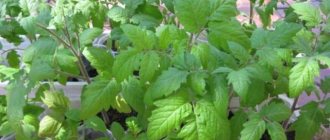Tomato Tatyana is a leader among varieties adapted for planting in unprotected areas. It takes root well without greenhouses, sets well and bears fruit consistently.
| Height | Landing location | Ripening time | Fruit color | Fruit size | Origin | Fruit shape |
| short | Greenhouse, Open ground | Early ripening | Reds | Average | Variety | Flat-round |
Description and characteristics of the variety
Tomato Tatyana is a standard determinate variety that is easy to grow. Among the features of bushes, the following criteria are distinguished:
- shoot height 50-70 cm;
- simple dark leaves;
- fruitful clusters with 3-5 fruits.
Tomato Tatyana “Sedek” is intended for open beds and planting in greenhouses, greenhouses, and biovegetarians.
Tomato characteristics and description of fruits:
- average weight 120-150 g;
- round, smooth shape;
- the flesh is fleshy, moderately juicy;
- the skin is strong;
- fruits are transportable and shelf-stable;
- with good marketability indicators.
The taste harmoniously combines sourness and sweetness.
Tomatoes are intended for universal use. Salads and assorted dishes are prepared from them. Add to first and second courses, preserve for the winter. Cover juices and pastes. A special treat is ketchup in Italian traditions.
Ripens early - 90-98 days from germination.
Advantages and Disadvantages of Culture
Neither breeders nor ordinary gardeners speak in detail about tomato yields in online reviews. The State Variety Commission certificate mentions a value of about 5 kg of marketable fruits per 1 sq. m. In this case, the variety is called high-yielding. General list of advantages:
- Convenient fruit size for various culinary tasks. Some specimens reach a weight of 250 g. On average, the harvest is smaller.
- Good taste and high-quality pulp structure. Tomatoes are used for fresh salads, canning, and processing into sauces and juices.
- Early maturation.
- Unpretentiousness to growth and care conditions. The tomato bears fruit normally even in bad weather. It can also be grown without additional measures: pinching and gartering.
- Increased resistance to late blight.
Attention! There is no official information about the culture's resistance to other diseases.
Cons of tomato Tatyana:
- keeping quality is not high enough for long-term storage and transportation of ripe crops;
- with excessive watering, the tomato skin bursts right on the bushes;
- the plant tends to grow green mass - the lower leaves will have to be torn off from time to time;
- Due to the small number of seeds in the pulp, it is labor-intensive to propagate the crop at home.
Attention! Varietal tomatoes are in demand among gardeners and farmers who want to get an early harvest.
The taste characteristics of fruits should be assessed with a discount for early ripening.
Features of cultivation and storage
The seedlings are ready for transplanting in 55-60 days. Bushes are planted in fertilized heated soil at a distance of 40 cm. The holes are made 20 cm deep.
What guidelines do agricultural techniques provide for increasing productivity:
- Watering is balanced at the roots.
- Fertilize 2 times a month using organic matter and a phosphorus-potassium mixture.
- Foliar feeding is used.
- The beds are loosened regularly or mulched with hay in a layer of at least 8 cm.
The variety does without pinching. The bushes are tied up at your discretion.
Growing seedlings yourself
Growing seedlings determines exactly how the crop will grow, what the fruits will be, and their quantity. Therefore, you need to know how to properly carry out each stage of growing a plant in order to get maximum results.
Sowing time
Sowing seeds must be done in early March from the 1st to the 10th - this is due to the fact that at this time of year the temperature and humidity are most suitable for the seeds to germinate well. The soil also plays a very important role, and at the beginning of spring it is saturated with enough water to nourish the future plant.
The soil
For soil you need to mix several products:
- Soil . Suitable both purchased and from the garden - it is only necessary that it contains a sufficient amount of moisture to nourish the seeds.
- river sand.
- Humus . It is necessary to accelerate growth and nutrition.
Since various pests or dangerous bacteria can often grow in the soil, it is recommended to disinfect it.
Important! It is also recommended to disinfect purchased soil, since even it can contain harmful bacteria!
There are several types of soil treatment:
- Freezing . Twice, with an interval of 3–4 days, the soil for planting must be exposed to frost of -15°C for several days.
- Heat treatment . Place a metal sheet with soil on a bucket or basin of boiling water for 1 hour.
- Treatment with drugs . These can be fungicides, insecticides, or simple potassium permanganate.
Soil preparation is a necessary initial stage, since the further growth of the plant depends on it.
Growing container
It is recommended to germinate seeds in special soil boxes. They can be made from different materials, but the most common are wooden boxes; they are also more environmentally friendly.
Seed preparation
Just as the land is disinfected, it is also necessary to disinfect seeds, since their surface may contain pathogens of various diseases, and if several infected seeds are mixed with others, then all will become unsuitable for use.
To treat seeds, you can place them in a 1% potassium permanganate solution for 20 minutes, then rinse with water and dry.
You can also use a growth stimulator, which will allow the seeds to germinate more efficiently. There are many drugs available, so the instructions for each of them are individual.
Important! It is necessary to treat seeds with growth stimulants strictly according to the instructions, since you can overexpose them and then they will not bear fruit!
If you are confident in the high quality of the seeds, you can not resort to previous preparation so carefully.
Sowing seeds
Seeds must be deepened to a distance of 1.2 to 2.2 cm. If the depth exceeds these indicators, they may not germinate.
Seedling care
The room temperature should not be lower than 23°C, since then the plant will freeze and sprouts will not appear. It is also necessary to sprinkle the soil on top with peat, if no other fertilizers were used, and cover the seeds with cling film.
When the first green shoots appear, you need to add a source of bright daylight - for example, place them on a window. If this is not possible, special lamps must be used. Watering is carried out as necessary, but at least several times a week, from a watering can or spray bottle.
Find out how to get rid of caterpillars on tomatoes.
Hardening of seedlings
Hardening of seedlings is a process of gradual transition to lower temperatures and their change day and night. Therefore, from the 3rd day after the sprouts appear, it is necessary to gradually reduce the temperature by 2-3 degrees at different times of the day. For example, on day 6, in sunny weather, it should be up to 21°C during the day, and up to 15°C at night.
Planting seedlings in a permanent place
At the end of May, it is necessary to transplant the sprouts into previously loosened and prepared soil (watering and fertilizer). Planting should be done at a distance of 33 cm to 43 cm, so the plants will not interfere with each other and get tangled.
Since the Tatyana tomato has very wide foliage, it is necessary to ensure that there is enough free space.
Diseases and pests
The Tatyana variety is resistant to a large number of dangerous diseases that affect vegetable crops of the nightshade family.
Tomatoes are not afraid of diseases such as:
- Verticillium;
- Spotted Mosaic;
- Fusarium.
For preventive purposes, the area with tomatoes is treated with preparations that contain copper.
To protect plantings from fungi, proper watering and mulching of the soil in the beds with peat or humus is necessary.
It is useful to treat young bushes with phytosporin or a weak solution of potassium permanganate.
Preliminary preparation of the soil will help protect Tatyana tomatoes from viruses - treating them with a solution of copper sulfate or calcining the top layer at a high temperature.
REFERENCE: Early ripening of tomatoes makes it possible to avoid the appearance of late blight.
Insects and pests that can threaten tomatoes of the review variety:
- Colorado beetle;
- Thrips;
- Whitefly;
- Aphid;
- Slugs;
- Medvedka.
Spraying the area with tomatoes with soapy water will help get rid of aphids. Whiteflies and thrips are afraid of celandine decoction. Colorado beetles and larvae are usually collected by hand.
Mulching the soil will protect plants from slugs and mole crickets.
In case of pest infestation, special insecticides should be used.
Vegetable growers' opinions about the variety
Gardeners have already managed to test Tatyana tomatoes on their plots throughout the country. Many people have fallen in love with this variety and now plant it every year. Reviews from summer residents about the Tatyana tomato note its unpretentiousness and early ripening, and the high quality of its rather large fruits.
Bezmennikova N.V. (Ryazan region): “I grow tomatoes only in street beds. In May I plant them under arches with spunbond, and in June I remove the cover. I have tried dozens of varieties, rejected many, but I have not changed the Tatyana variety for ten years. I appreciate it for its unpretentiousness and annual good harvest. More than half turn red on the bushes, the rest of the tomatoes ripen perfectly at home.”
Potekhina Elizaveta (Sverdlovsk): “Our family doesn’t have time to bother with tall tomatoes. We raid the plot, so we grow varieties for “lazy” summer residents. We sow Tatyana tomatoes for seedlings not too early - in early April. We plant directly into the ground. The bushes bloom quickly. We don't stepchildren them. The tomatoes are not too big, but there are a lot of them.”
Kostenko A.V. (Pskov region): “I was given tomato seeds by Tatyana, because my granddaughter is called by this name. The variety turned out to be successful and remained in my collection. It sits in my bed all summer under arches with covering material. The bushes are not too tall, but spreading. I don’t place more than four pieces on one square meter. Both I and my granddaughter are happy with the harvest. We eat ripe tomatoes straight from the bush.”
The advantage of the Tatyana tomato is that the variety is not an F1 hybrid. You can get your own seeds from it and not spend money on buying them every year. The best tomatoes from the second cluster of the most productive bushes are used for seeds.
https://7ogorod.ru/paslenovyj-i-tykvennye-ovoshhi/tomat-tatana-harakteristika-i-opisanie-sorta.htmlhttps://agronom.expert/posadka/ogorod/paslenovye/tomat/tatyana.htmlhttps:// dachamechty.ru/tomat/rassada/tatyana.html
Requirements for growing conditions
Among the main growth requirements are:
- warmth and light;
- humidity;
- soil preparation;
- fertilizer.
The winter wheat variety Tanya needs long days. Different growing seasons require different heat levels. Due to its frost-resistant characteristics, grains can germinate even at +1°C, but for mass growth a higher temperature is needed. The first shoots appear approximately a week after sowing, if the air temperature is from +14°C to + 16°C. Then, in the next 30–40 days, if the air temperature is from + 11°C to + 16°C, tillering occurs.
Winter wheat is also demanding on the soil. It should have nutritional properties and a favorable composition of water and physical substances. In order for the plant to harden, it is important to sow it at the optimal time and provide the wheat with a sufficient amount of potassium and phosphorus. The first hardening cycle occurs in the autumn-winter period.
Did you know? The Slavs considered wheat a symbol of wealth and life cycle. It served as a strong talisman protecting against the evil eye and damage.
To obtain full-fledged seedlings, the productive soil moisture must be at least 1 cm. In the tillering phase, the productive moisture coefficient must be at least 30 mm. The greatest amount of moisture is lost by the plant during the period from regrowth in the spring to heading.
Wheat Tanya requires nitrogen as nutrition already in the first days of harvest. She needs the substance before the grain appears. In addition, it needs the consumption of phosphorus and potassium at different periods - from emerging into the tube to the formation of the ear and flowering.
